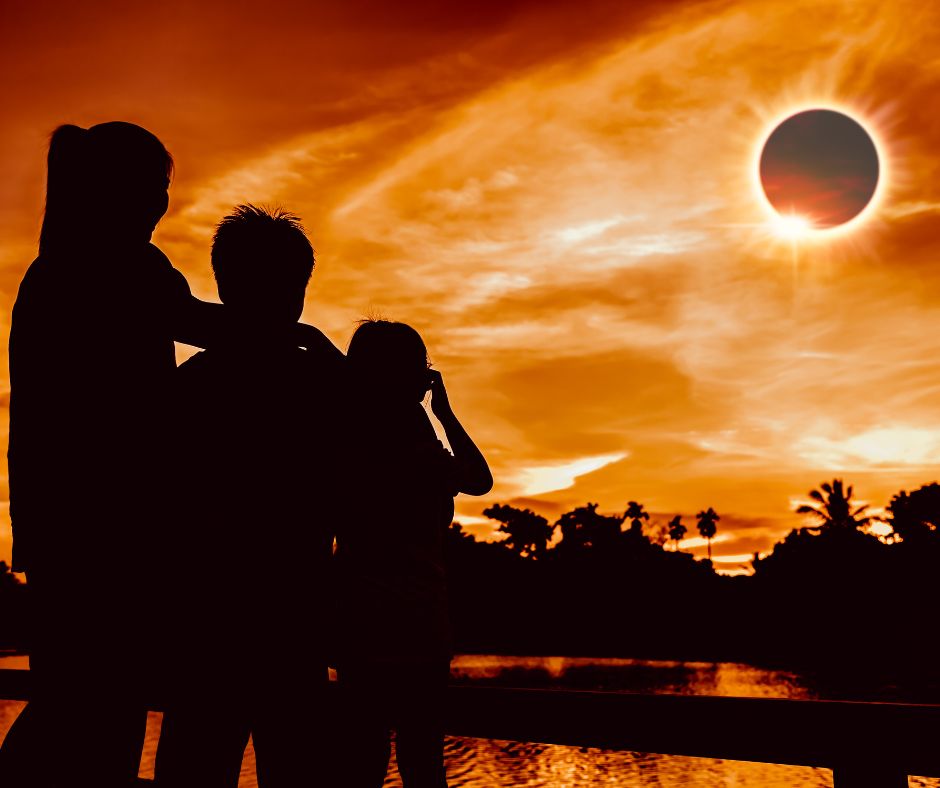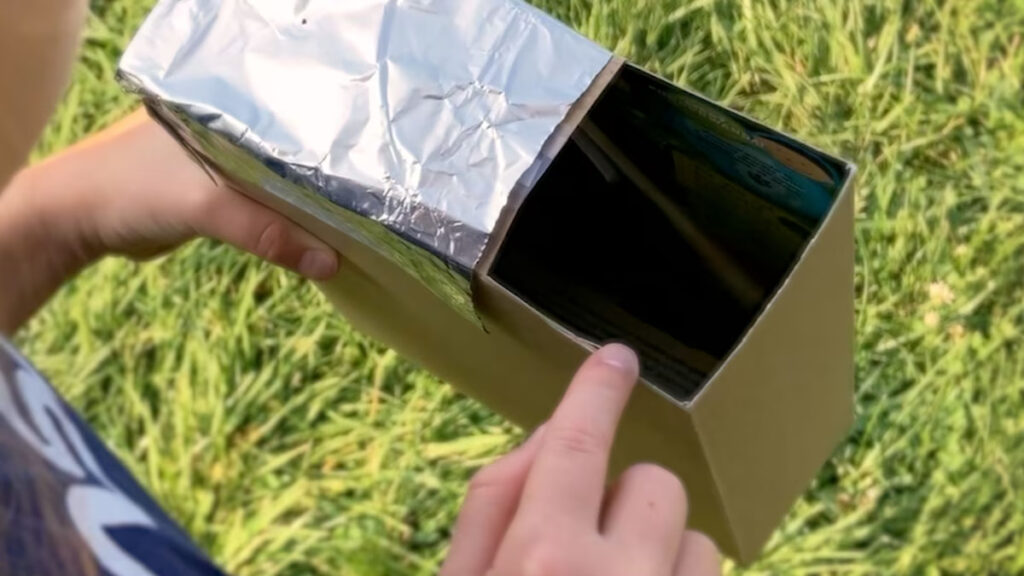A total solar eclipse is heading your way! On April 8, 2024, a total solar eclipse will be able to be seen across parts of Mexico, the US, and Canada and we have front row seats here in Burlington!

What is a solar eclipse?
The easy explanation is that a solar eclipse happens when the moon moves between the Earth and the Sun, blocking the light from the Sun and casting its shadow on the Earth.
When is the Next Solar Eclipse?
On April 8, 2024, a total solar eclipse will be able to be seen across parts of Mexico, the US, and Canada
Is it a big deal if I miss it?
Only if you don’t want to travel to see one. Total eclipses happen about every 18 months but it can only be seen from the same place about once every 330 years! The next total eclipse to be seen in Canada will be in 2044 in the Northwest Territories and Alberta.
Sounds simple – so what’s so special?
It is pretty simple, but there are a lot of things that have to come together to create a solar eclipse, which is why they don’t happen all the time, and why not everyone gets to see one, even when they do happen.
You’ve probably seen diagrams of the planets and moons going around the Sun in perfect circular orbits with everything in line, like marbles rolling around on a plate. If that was true there would be an eclipse every 27 days when the moon moves around the Earth and gets between the Earth and the Sun. In real life the moon’s orbit around the Earth is tilted and oval, both of which help to make eclipses such a rare event.
Most of the time when the Moon passes between us and the Sun it’s too high or too low on that tilted orbit for its shadow to fall on the Earth. Imagine the screen you are reading this on is the Sun and your face is the Earth. Hold your hand at an angle between you and the screen like you are going to karate chop it. If the Moon were at the tips of your fingers the shadow coming towards you would likely miss you and go by your ear or your shoulder. If it were by your wrist, the same. Usually the moon is somewhere on that tilted orbit that means its shadow misses the Earth and we don’t get an eclipse.
Have you ever noticed sometimes the Moon looks huge? That’s because of that oval orbit. Things that are far away look smaller than ones close up, so there are times when the Moon is closer and looks bigger, or further away and looks smaller. What does that mean for an eclipse?
The Moon has to be the perfect distance away from the Earth to block out all of the Sun. If it’s too far away it’s smaller in the sky and doesn’t block out the whole Sun. When that happens we actually do get a kind of eclipse called an annular eclipse where the Moon looks like a dark disk on top of a bright ring of Sun but doesn’t completely block the Sun.
The last piece is the shadow of the Moon on the Earth isn’t very big so not everyone will be in the shadow and see the eclipse. The shadow traces a path on the Earth’s surface called the Path of Totality. When you are right in the centre of the Path you will see the Sun blocked, or “totality”, for a few minutes. As you get further from the centre, the time the eclipse spends in totality is shorter. Further out from the path you will still see a partial eclipse, but the Sun won’t be blocked completely, until finally you are so far away from the path you won’t see any difference to the Sun at all.
Here in Burlington we should see totality, but maybe only for about a minute as we are right on the edge of that Path of Totality. If you want to travel to make sure you see the full eclipse for as long as possible, head towards Niagara Falls, Port Dover, anywhere along Lake Erie towards Point Pelee, or Kingston, Belleville, Cornwall area. See an interactive map of the Path here (there may be a few other people with the same idea – check traffic before leaving!!)
The whole event will be around 2 and a half hours, from what’s called First Contact, where the Moon first ‘touches’ the side of the Sun, through partial eclipse, totality, another partial eclipse, to the Sun being completely visible again.
Besides being in the right place, you also need the right equipment, such as eclipse glasses (not sunglasses or welding goggles), or a way of projecting the Sun’s image. Don’t worry, more information and instructions are below!
What To Expect From The Total Solar Eclipse 2024
The eclipse officially starts with First contact, where the Moon first ‘touches’ the edge of the Sun which is an odd name since the Moon and Sun are still around 150 kilometres away from each other – they don’t come into contact at all! From there, the Moon moves across, the dark circle looking like it’s taking a bite out of the Sun, that’s the partial solar eclipse.
In Burlington this stage will be around 2:00 to 3:15pm. From about 3:00 you’ll want to be in your best viewing position, because things happen quickly! Use the search bar on this site to get the timings for your City.
As that partial eclipse gets closer and closer to totality there are some cool things to look out for: About a minute before totality you may see shadow bands which are wavy bands of shadow and light moving on the ground and along walls almost like being at the bottom of a swimming pool. Next, as the Moon moves into position the last of the light shines through valleys on the edge of the Moon creating little dots, called Bailey’s beads. Eventually only one point of light is visible, looking like a diamond on a ring.
Baileys beads and the Diamond Ring Effect are only seen in the last 10-15 seconds before totality, but there’s another chance to see them as the Moon moves through and the light starts to be seen on the other side.
Totality, or second contact, where the last of those Bailey’s beads have disappeared is the only time it is safe to look at the Sun with the naked eye – remember, it may last for less than a minute. If you do take a peek you should see the Sun’s corona, or the spiky halo of gases that surround the Sun. That is what the Sun looks like, it’s just usually too bright to see that outer ring and we only see the circular shape. You may also be able to see some of the brightest stars and planets in the sky.
As Bailey’s beads start to show again, also called Third Contact, go back to viewing safely with your solar eclipse glasses or projector and then see the whole sequence in reverse – the partial eclipse showing more and more sun until the whole disc can be seen again – Fourth Contact.
Cool Fact: While what’s happening in the sky is spectacular, don’t forget to look around you, and feel the surroundings too. As the skies darken during the partial eclipse animals can get confused. Birds may stop singing, nocturnal animals like bats may start to come out and spiders start tearing down their webs, then start building them again as the Sun begins to show. Also, the temperature will drop and the wind will die down, and as it comes back may be in a different direction!
How do we safely view the eclipse?
Glad you asked – you should never look directly at the Sun even when most of it is being blocked by the Moon! No, not even through sunglasses. Most sunglasses have some kind of UV protection which blocks the ultraviolet rays that can do harm to your eyes, but it is not just the type of light coming into your eye that is the problem – it’s the intensity.
The retina at the back of your eye is made up of light sensitive cells. Normally, light comes into your eye and the cells get activated, sending signals along the nerves to the brain which then makes sense of what you are seeing. Your eye also has a lot of liquid in it (called the Vitreous Humour) that acts like a magnifying glass. If you stare at the Sun, you’re focussing all of that energy onto the retina, potentially damaging or destroying those light sensitive cells. There are no pain cells in the back of the eye, so you won’t feel anything, but the damage is happening. Unlike most other kinds of cells, your body doesn’t replace the cells in the eye, so once they are damaged they are damaged.
There are lots of ways to safely see the eclipse though – special solar eclipse glasses block nearly all visible, ultraviolet and infrared light (they are about 100,000 times darker than sunglasses) or you can project an image of the sun using things you probably have around the house.
If you are going to buy glasses, look for the industry standard of ISO 12312-2 (just cut and paste that number into any search engine or store you are looking at). A few places to look into can be found here, and we’ve heard Canadian Tire is selling some as well.
Other Ways To Safely View The Solar Eclipse in April 2024
National Geographic Kids has a great tutorial on how to make your own solar eclipse viewer with some items from around the house. We love cheap science crafts and experiments!
Hopefully we’ve convinced you to take part in this once in a lifetime event happening in our own backyards! If you want to join a Viewing party, check out these events:

Solar Eclipse Events and Activities Near Hamilton, Burlington, Oakville
Read Our Latest Articles
Catch up on what we’ve been covering! Here are our latest reads, hot off the presses just for you. Never miss an article when you subscribe to our weekly newsletter filled with kid-friendly fun and events.




